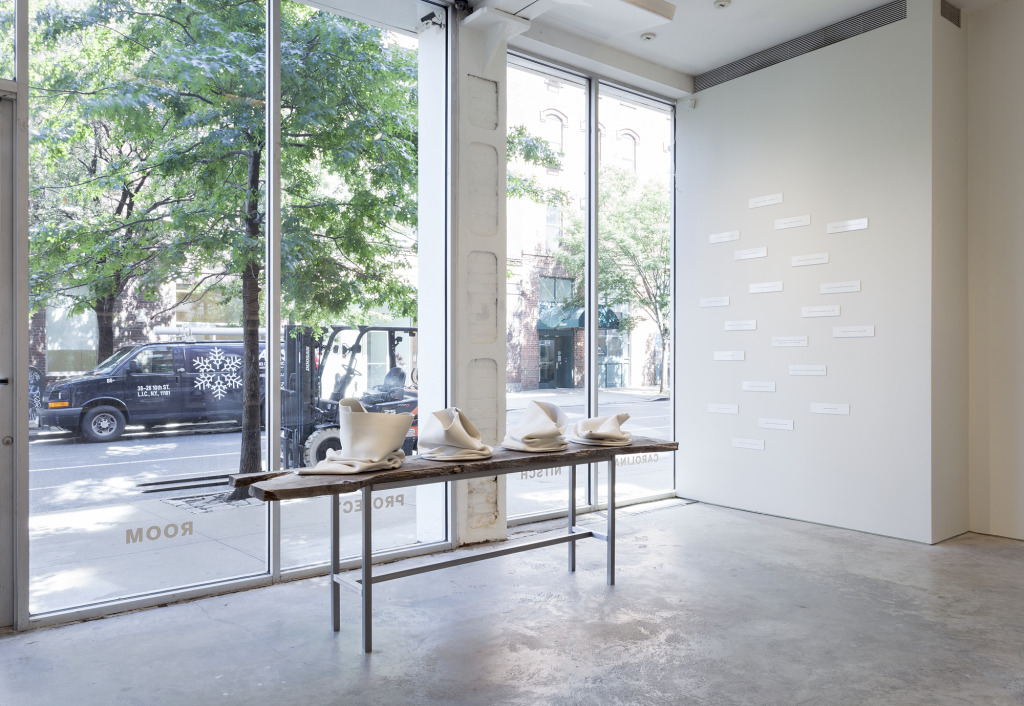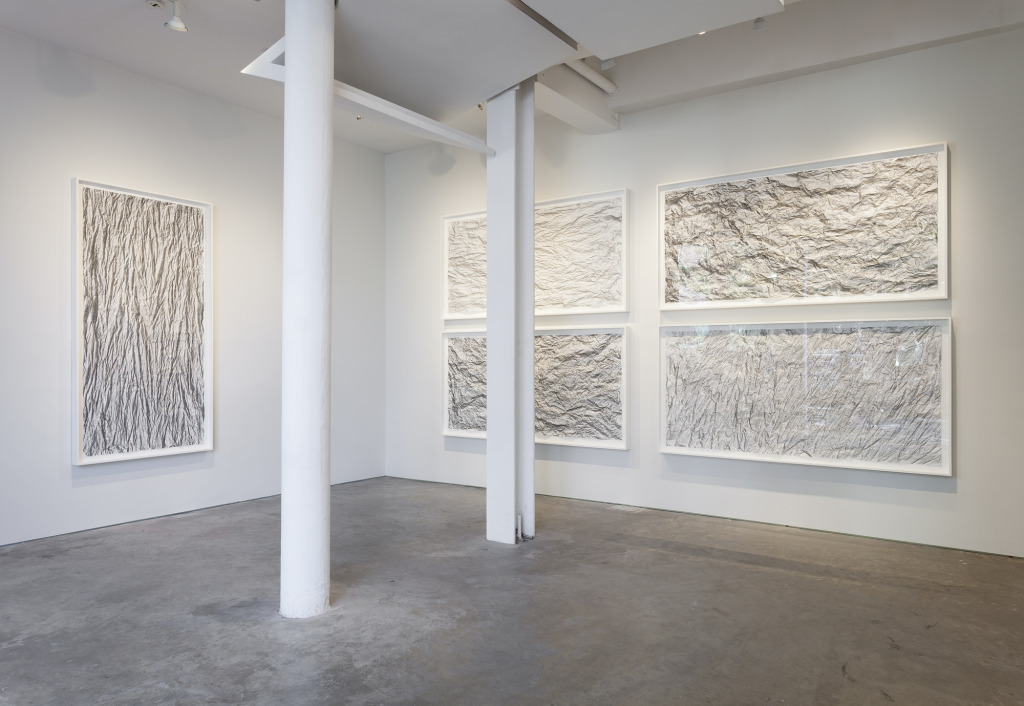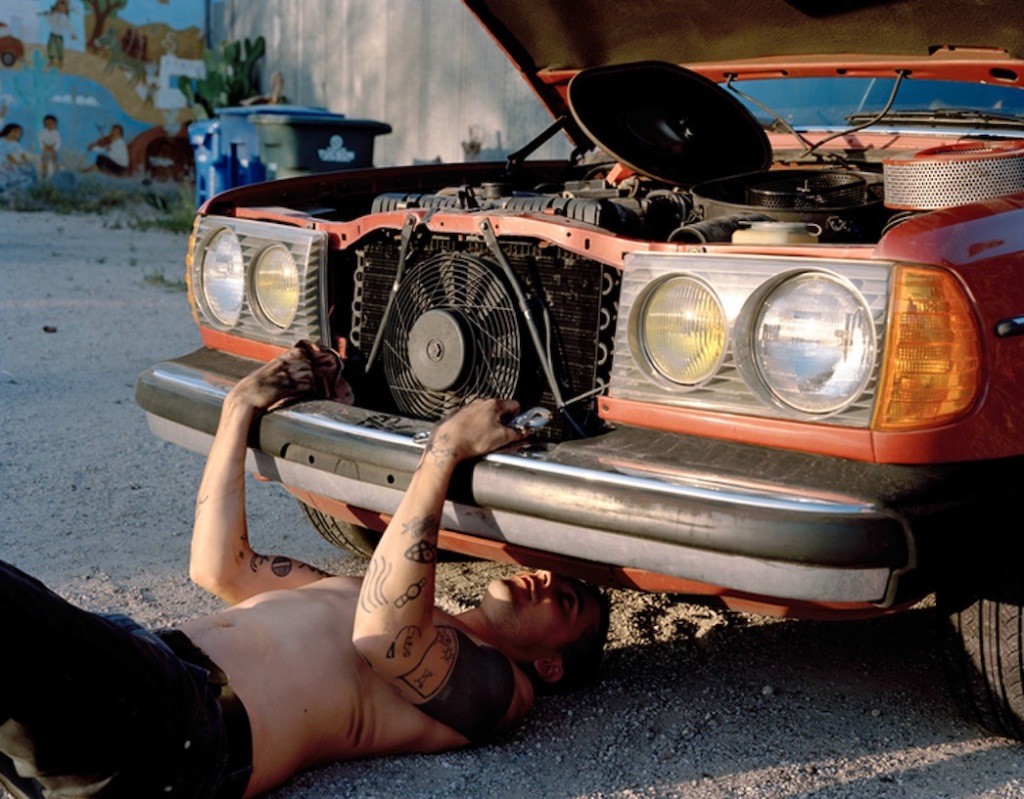ETTD contributor Ayden M. Grout recently visited Chelsea and her top three picks from the neighborhood are below.

Alyson Shotz, Topographic Iterations, Installation view at Carolina Nitsch Project Room, New York, 2014, Photograph courtesy of the gallery
Carolina Nitsch Project Room is an unostentatious space that is currently showing the white and gray work of Alyson Shotz. Shotz’ Topographic Iterations, six large swaths of crumpled paper, hang lightly giving the space dimension without challenging the whiteness of the walls. The shadows among the mountains and valleys of the paper don’t quite align though, and closer inspection reveals that Shotz has photographed a crumpled piece of paper, and then crumpled the photographic print. Not only do the crushing folds carry the photograph in the sculptural realm, they create an echo. Proust said “photography is the product of complete alienation” so by inserting the photographic process between the repeated action of crumpling the paper, Shotz creates the distance Proust reminds us is a necessary part of photographic imagery. She builds a palimpsest, allowing the final piece to wear the skin of the first. (I am tempted to liken the work to t-shirts that have ties or tuxedos printed on the cotton, though I don’t want to cheapen Shotz’ exquisite forms to mass-produced garments).

Alyson Shotz, Topographic Iterations, Installation view at Carolina Nitsch Project Room, New York, 2014, Photograph courtesy of the gallery
Alyson Shotz fascination with collapsed material continues with Recumbent Folds, four thick yet delicately crumpled porcelain tubes sitting on an ash-colored wood table at the front window. She dropped these ceramic sculptures from various heights and they carry the weight of a collision due to gravity. The creased bottoms elegantly measure their impact with earth. Shotz is interested in the trace we leave on discarded materials, the mark-making of abandon. Her minimal palette elevates the textural and sensual components.
Her affinity for lyrical gesture in sculpture translates fluidly from three-dimensions to the written word in Imaginary Sculptures. An unassuming cluster of tin signs printed in diminutive cursive, hang on one wall, each with a single phrase, an idea, a note to the self about a hypothetical creation. One reads, “a sculpture made if wind.” Another plaque proposes “a sculpture that changes shape each night,” while yet still another imagines “a sculpture that is dispersed in the air.” Some are like lyrical puzzles, while others seem more feasible such as “a sculpture buried underground” or “a sculpture made of flour, submerged in oil.” The three series of work presented at Nitsch represent a rare gem of literal poetics in contemporary art, a sometimes impossibly buried needle in the haystack of the art world.

Mary Ellen Bartley, Untitled #22, 2009 © Mary Ellen Bartley, Courtesy of the Artist and Yancey Richardson Gallery
Across the street at Yancey Richardson Project Gallery, the wave of white and its many subtleties continue in Mary Ellen Bartley’s photographic series Paperbacks. Turning the spines away from the viewer, Bartley assembles the tonal variations of white pages in stacks that present sculptural studies. Bartley is clever; by divorcing the books in the photos from language her work bleeds from still life into abstraction. Using the recognizable form of a book to create fields of restraint, she allows the stacks, shadows and light to compose serene images.

Justine Kurland, 280 Coup, 2012, Inkjet print, (edition of 6), Mitchell-Innes & Nash, New York, 2014. Image courtesy of the artist and the gallery.
On 26th Street, at Mitchell-Innes & Nash, Justine Kurland’s first show at the gallery in five years, Sincere Auto Care, is on view. Cars seem an unexpected arena to turn her photographic lens on after earning a reputation with romanticized images of nude mothers and runaways. The world Kurland captures now is filled with exhaustion and death, smoke and grit. Gone are the swollen bellies of nubile women, lush forests touched by crystalline dawns, and sweeping views of trains carving through mountains. Now she turns to the innards of cars spilling onto roadsides, sinking into dusty lots, and men slick with grease, ravaged by machines, motors, exhaust, oil. As Kurland herself says, she turns to a place “where beauty is found not because the world is beautiful but because it is beautifully described.” Kurland has avoided the temptation to join the trend of making massive prints that fill one’s field of vision. She shows restraint and her work impresses with a flourish of light rather than scale.
The male mechanics that are the central subject of Sincere Auto Care exist in an intriguing paradigm. They are emblems of masculinity; tattooed and often with a cigarette in hand. Yet there is a docile edge in the way so many of the subjects lie, surrendered on the ground under the hoods of vehicles. They are as vulnerable as a lover beneath these weighty masses of metal. Her photographs are filled with arms and hands, and within them we witness virility and care, tenderness and strength. A stillness seems to exist simultaneously with the labor of these men. It is here where Kurland gathers her most poetic moments, the paradox of waiting and working, apathy and devotion. She is no longer imagining idealistic scenes; she is seeing the beauty of contradiction.
_________________________
Alyson Shotz’s Topographic Iterations will be on view thru November 15. Mary Ellen Bartley’s Paperbacks is open until October 18. Justine Kurland’s Sincere Auto Care will be up thru October 11.
